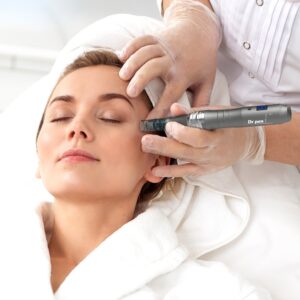Microneedling: The Complete Guide to Collagen Induction Therapy
Introduction
Microneedling has emerged as one of the most effective minimally invasive treatments for skin rejuvenation. Also known as collagen induction therapy, this procedure uses fine needles to create controlled micro-injuries in the skin, triggering the body’s natural healing process and stimulating collagen and elastin production. The result? Firmer, smoother, and more youthful-looking skin with improved texture and tone.

How Microneedling Works
- The Science Behind It
- Tiny needles (0.5mm–2.5mm in length) puncture the skin’s surface.
- This controlled trauma signals fibroblasts to produce new collagen and elastin.
- Blood flow increases, delivering nutrients for faster skin repair.
- Treatment Depth Variations
- Superficial (0.2–0.5mm): For mild texture issues and product absorption enhancement.
- Medium (0.5–1.5mm): Targets fine lines, acne scars, and moderate pigmentation.
- Deep (1.5–2.5mm): For severe scarring and deep wrinkles (requires professional care).
Key Benefits of Microneedling
- Anti-Aging: Reduces fine lines and improves skin elasticity.
- Scar Reduction: Effective for acne scars, surgical scars, and stretch marks.
- Pore Minimization: Tightens enlarged pores for a refined complexion.
- Hyperpigmentation: Fades sunspots and melasma by promoting cell turnover.
- Product Absorption: Enhances penetration of serums by up to 80%.
The Microneedling Procedure: What to Expect
- Pre-Treatment Prep
- Avoid retinoids, sun exposure, and blood-thinning medications 3–5 days prior.
- Skin is cleansed and numbed with topical anesthesia (for deeper treatments).
- During the Session
- A dermaroller or pen-like device glides over the skin.
- Mild discomfort (often described as “tingling” or “prickling”).
- Treatment duration: 30–60 minutes, depending on area size.
- Post-Treatment Care
- Redness and swelling (similar to sunburn) for 24–48 hours.
- Use gentle, hydrating products (hyaluronic acid, ceramides).
- Strict sun protection with SPF 30+ to prevent UV damage.
At-Home vs. Professional Microneedling
| Factor |
At-Home (Dermarollers) |
Professional (Pen Devices) |
| Needle Depth |
≤0.5mm (superficial) |
Up to 2.5mm (customizable) |
| Safety |
Risk of infection if not sterile |
Sterile, controlled environment |
| Results |
Mild improvement |
Dramatic, long-lasting effects |
| Cost |
$20–$100 per device |
$200–$700 per session |
Note: Deep microneedling (>1mm) should always be performed by a licensed practitioner.
Ideal Candidates & Contraindications
✅ Best For:
- All skin types (including sensitive skin).
- Those with acne scars, wrinkles, or uneven texture.
- Patients seeking non-laser alternatives.
❌ Avoid If:
- Active acne or skin infections are present.
- You have eczema, psoriasis, or rosacea flare-ups.
- Pregnant or using isotretinoin (Accutane) within the last 6 months.
Combination Therapies for Enhanced Results
- PRP (Vampire Facial): Platelet-rich plasma accelerates healing.
- Radiofrequency (RF Microneedling): Adds heat for collagen remodeling.
- Growth Factor Serums: Boost recovery and collagen synthesis.
Expected Results & Timeline
- Initial Glow: 3–5 days post-treatment (plumper skin).
- Collagen Peak: 4–6 weeks (optimal results appear).
- Full Effects: After 3–6 sessions (spaced 4–6 weeks apart).
Conclusion
Microneedling bridges the gap between topical skincare and invasive procedures, offering a safe, versatile solution for skin renewal. Whether addressing aging, scarring, or dullness, its collagen-boosting power delivers transformative results with minimal downtime. For best outcomes, consult a dermatologist to tailor the treatment to your skin’s unique needs.
Pro Tip: Maintain results with biannual maintenance sessions and a collagen-supportive diet (rich in vitamin C, zinc, and protein).
